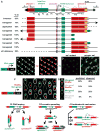Interchromosomal communication coordinates intrinsically stochastic expression between alleles
- PMID: 24503853
- PMCID: PMC4134473
- DOI: 10.1126/science.1243039
Interchromosomal communication coordinates intrinsically stochastic expression between alleles
Abstract
Sensory systems use stochastic mechanisms to diversify neuronal subtypes. In the Drosophila eye, stochastic expression of the PAS-bHLH transcription factor Spineless (Ss) determines a random binary subtype choice in R7 photoreceptors. Here, we show that a stochastic, cell-autonomous decision to express ss is made intrinsically by each ss locus. Stochastic on or off expression of each ss allele is determined by combinatorial inputs from one enhancer and two silencers acting at long range. However, the two ss alleles also average their frequency of expression through up-regulatory and down-regulatory interallelic cross-talk. This inter- or intrachromosomal long-range regulation does not require endogenous ss chromosomal positioning or pairing. Therefore, although individual ss alleles make independent stochastic choices, interchromosomal communication coordinates expression state between alleles, ensuring that they are both expressed in the same random subset of R7s.
Figures




References
Publication types
MeSH terms
Substances
Grants and funding
LinkOut - more resources
Full Text Sources
Other Literature Sources
Molecular Biology Databases

